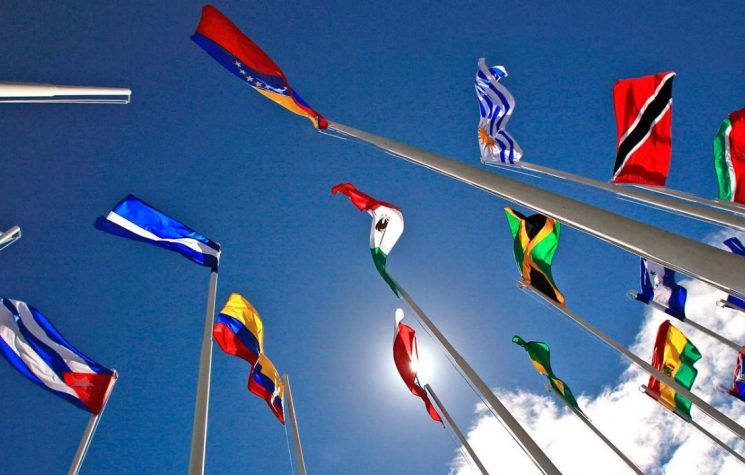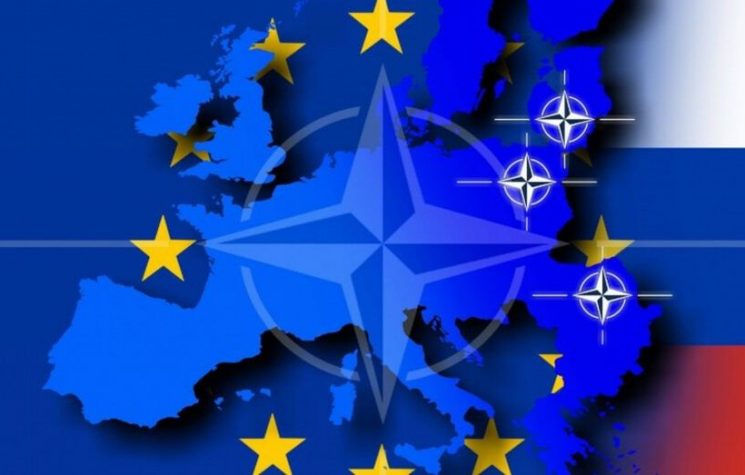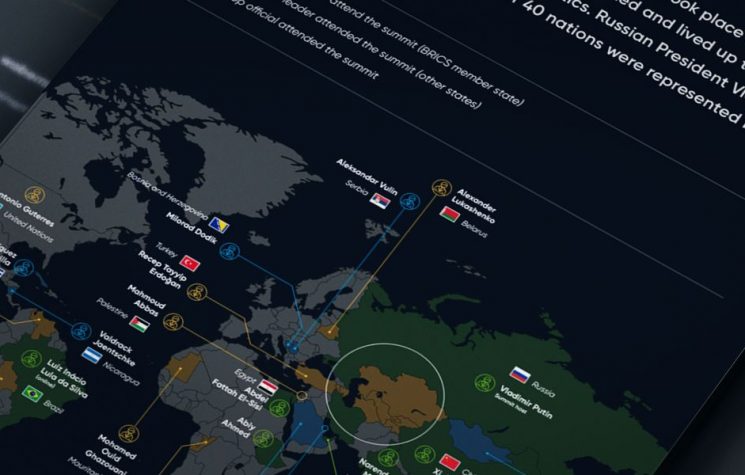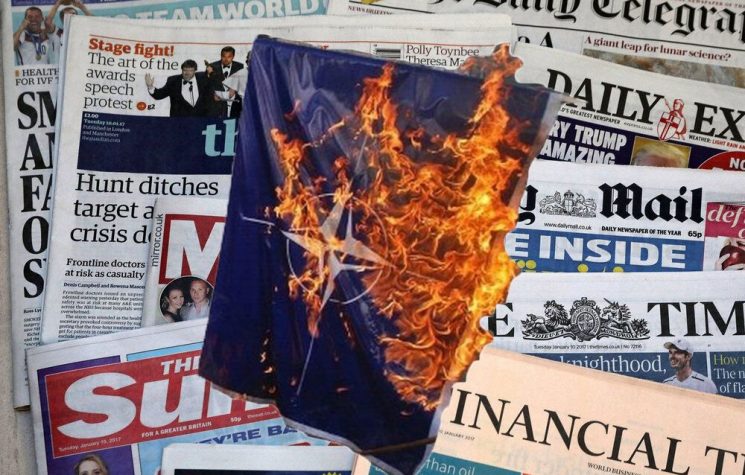It is the first time that others are dictating to the West rather than being instructed on how to conform to American red lines.
There was an almost audible sigh of relief echoing around western corridors. Though there were no breakthroughs in the Team Biden-Putin virtual meeting, the talks not surprisingly, were heavily focussed on the matter of immediate concern: Ukraine – amid widespread fears that the Ukrainian volcano might irrupt at any moment.
At the meeting: Agreed was the proposal to initiate ‘lower-level’ government-to-government discussion of Russia’s red lines and any halt to NATO expansion eastwards. Jake Sullivan, however, spilt a little cold water over that when he firmly emphasised that the U.S. had given no commitments on either issue. Biden (as advertised in advance), warned of strong economic and other measures should Russia intervene in Ukraine.
What was more notable however, was that the U.S. is ‘only’ threatening to sanction Russia, or to move more troops into the region, as opposed to posing explicit western and NATO militarily intervention in Ukraine. In earlier statements, Biden and other U.S. officials have been vague about what Washington’s response to a Russian invasion would be: warning repeatedly of ‘consequences’, even as it re-committed to Ukraine’s sovereignty.
So, should we all begin to breathe again? Actually, no. In fact, the immediacy of the Ukraine issue was always something of a red-herring: Russia has no desire to wade into the thick, cloying mud of a regional quagmire, however much some in the West would ‘love it’. And the Kiev forces are tired, bedraggled and demoralised from sitting in cold trenches along the Contact Line for months. They have little appetite to take on the Donbass militias (unless aided from the outside).
Nothing was resolved about what to do about the wider dark dystopia that is Ukraine – in all its various manifestations. President Putin raised the Minsk Accord, but nobody, it seems, was biting; the fishing line remained limp. Nor was anything agreed about what to do with the accumulating debris of what once was called U.S.-Russian ‘diplomatic relations’. The latter term (diplomatic relations) is now but a poor joke.
Celebration therefore, is not in order. The viscerally anti-Putin factions in U.S. and Kiev are furious: A U.S. Republican Senator, Roger Wicker has warned that in any stand-off over Ukraine, “I would not rule out military action. I think we start making a mistake when we take options off the table, so I would hope the president keeps that option on the table”. Asked what military action against Russia would comprise, Wicker said it could mean “that we stand off, with our ships in the Black Sea – and we rain destruction on Russian military capability”, adding that the U.S. also shouldn’t “rule out first-use nuclear action” against Russia.
So Ukraine festers on. If we are now to have a lull, then it is just that – ‘a lull’. The ‘hawks’ in U.S. and Europe have not raised the white flag: Ukraine is too good a weapon for their needs, to be tossed lightly aside.
This focus on the Ukraine crisis however, is to ‘see the trees, yet miss the wood’: We have three – not one – ticking landmines, ready to ignite. Three ‘fronts’: Each are distinct, yet closely inter-related, and are now threaded by unknown levels of strategic aims and synchronicity: Ukraine, Taiwan, and the faltering JCPOA Accord – which is now sparking untold angst in Tel Aviv.
The wood not seen for these three trees lies with the unresolved issue of European security architecture; Middle East security architecture; and indeed, of global security architecture. The existing rules-based order has passed its sell-by date: It provides neither security, nor does it reflect the reality of today’s Great Power balances. It has become a pathogen. Simply put, it is too fossilised in the post-WW2 lietkultur.
In a recent CNN interview, Fareed Zakaria, asked Jake Sullivan, Biden’s Security Adviser: So what is it, after all your ‘tough talk’, that you have been able to agree with China; what has been negotiated? ‘Wrong question’ was Sullivan’s sharp retort. “Wrong metric”, he said flatly: Don’t ask about bilateral agreements – ask about what else we have secured. The right way to think about this, he said, is: “Have we set the terms of an effective competition where the U.S. is in a position to defend its values and advance its interests – not just in the Indo-Pacific, but around the world…”.
“We want to create the circumstance in which two major powers will operate in an international system for the foreseeable future – and we want the terms of that system to be favourable to American interests and values: It is rather, a favourable disposition in which the U.S. and its allies can shape the international rules of the road on the sorts of issues that are fundamentally going to matter to the people of our country [America] and to the people everywhere … “.
It is this maximalist lietkultur which is leading us to a point where these three explosive issues together risk a fundamental convulsion of the global order. You have to go back a long way to find a moment when our world was as vulnerable to a sudden change in fortunes – what Ambrose Evans-Pritchard in The Telegraph terms, “The West’s nightmare: a war on three fronts”.
What is going on? Well, it is certainly something very far-reaching. And why the U.S. insistence on such an absolute stance for the global order – according to which other Great Powers get no right to set their own security red lines? Well, it is because … the ‘four horsemen’ of the Great Transitions:
The Pandemic – leading into a global health regulatory system; the Climate Emergency – leading to a global CO2 regime of credits and debits; the tech and AI revolution – leading us into a global era of automation and ‘bots’ (and job losses); and fourthly, the Transition from classical economics to that of global Modern Monetary Theory that requires a global re-set of the world’s mountain of debt that will never be repaid.
Sullivan’s vision of the ‘foreseeable future’ is essentially conceived around this ‘higher order’ project: The preservation of global ‘rules of the road’, framed to reflect U.S. and allied interests’, as the base from which the clutch of ‘transitions’ – health, climate change, managerial and monetary technocracy – can be levered from the national parliamentary prerogative, up to a supra-national level of business and tech managerial collectives of ‘expertise’ (devoid of accountability to national parliamentary oversight).
Separated in this way into such spheres as health precautions, climate recovery, fostering tech ‘miracles’, and money issuance severed from taxation – they sound non-ideological, and somehow almost utopian.
It was well understood that all these transitions would overturn long-standing human ways of life that are ancient and deeply rooted, and inevitably would trigger dissidence – which is why new forms of social ‘discipline’, and the usurpation of control from national accountability, to the supranational plane, is so important. It certainly isn’t making people “happy”, (as per Davos).
Hmmm! … the ideological underbelly to this ‘higher order’ re-set may be obscured from view, as non-partisan, but it is he who decides the international standards, the protocols, the metrics, and the rules for these transitions, who is Sovereign – as Carl Schmitt once noted.
Sullivan at least has the integrity to be frank about the unseen ideology to the re-set: “We want the terms of that system to be favourable to American interests and values: It is rather, a favourable disposition in which the U.S. and its allies can shape the international rules of the road on the sorts of issues that are fundamentally going to matter to the people of our country [America] and to the people everywhere …”.
We are talking here of something which clearly goes well beyond the scope of the Biden summits with Xi and Putin, and the Vienna JCPOA talks. President Putin has warned that any encroachment of NATO infrastructure or forces into Ukraine would not be permitted. And that Russia would decisively act to prevent it. Similarly, Iran has stated explicitly that any Israeli attack on its nuclear facilities will not be tolerated. It would result in the Iranian destruction of Israeli vital infrastructure across the full territory.
And Iran’ and Russia’s stance is identical with that of China in respect to Taiwan: President Xi made that plain in the virtual summit that he held with Biden on 15 November. Xi warned that any move by Taiwan to secede is not permitted, and would be met by a military response.
In Vienna, Iran simply stated its ‘red lines’: No discussion of Iran’s ballistic missiles; no discussion of Iran’s regional role; and no freezing of enrichment – as long as the mechanism for lifting sanctions and ensuring their non-recurrence is not agreed upon – effectively calling for a return to the original framework of the 2015 accord. Iran demands binding guarantees that sanctions will not arbitrarily be re-imposed; that trade normalisation will not be informally hobbled again contrary to the terms of the accord, as happened under Obama (the U.S. Treasury Department pursued its own anti-trade policy, at variance with that of the White House); and that all sanctions must be lifted.
What should be noted here is the context: Note that the Iranian position is almost identical in content to that enunciated by Russia, vis à vis the U.S., in respect to Ukraine: Putin’s demand to Washington is that Russian interests and ‘red lines’ be formally acknowledged and accepted; that legally binding agreements be made in respect to Russia’s security in eastern Europe; and the absolute demand for no further NATO encroachment to the East, and a veto on any NATO infrastructure exported to Ukraine.
This is very new – in geo-politics, co-incidences of this nature don’t just spontaneously happen. It is evident that the three powers are strategically co-ordinated, politically and likely militarily, too.
Western states are stunned: It is the first time that others are dictating to them – setting out their red lines – rather than being instructed on how to conform to American red lines. They are disconcerted, and unsure what to do next. And, as Anatol Lieven astutely notes, some actions would have grave strategic consequences: “quite apart from the global economic damage that would result from a war in Ukraine, and the ways in which China would take advantage of such a crisis, the West has a very strong reason indeed to avoid a new war: the West would lose”. Lieven continues: “This would also risk becoming a world war; for it is virtually certain that China would exploit a war between the United States and Russia, thereby threatening the United States with the risk of two wars simultaneously – and defeat in both”.
For now, the U.S. and its allies repeat the usual bromides about ‘all options being on the table’; of crippling sanctions, and of an international coalition being formed to pressure and oppose such non-compliance. For, without competitor compliance (or these states’ effective political isolation and condemnation), the higher project of raising these seemingly ‘non-ideological’ transitions to a supra-national sphere whose standards, protocols, etcetera (‘terms of the system’ in Sullivan’s words) will not be achieved. It will not prove possible to upload a ‘Washington Consensus’ software update when these three states simply refuse Sullivan’s ‘rules’.
A strategic reset however will not come easily. The west is embedded in meme-warfare, which makes a strategic order partition all the harder. Any compromise on the narrative that Russia cannot have its own red lines; cannot dictate whether not Ukraine joins NATO; nor determine where NATO sites its missiles and nukes, risks Biden being seen as weak. Republicans already pre-emptively have blamed what they call Biden’s ‘weakness’ for having encouraged ‘dangerous adventurism’ from Moscow.
Then again, perhaps these two summits – together with Iran’s stance in Vienna – represent the beginning of the end to the West’s Rules-Based Order, and a countdown to a new geo-strategic balance between the two axis – and ultimately therefore, to peace or war.




























































